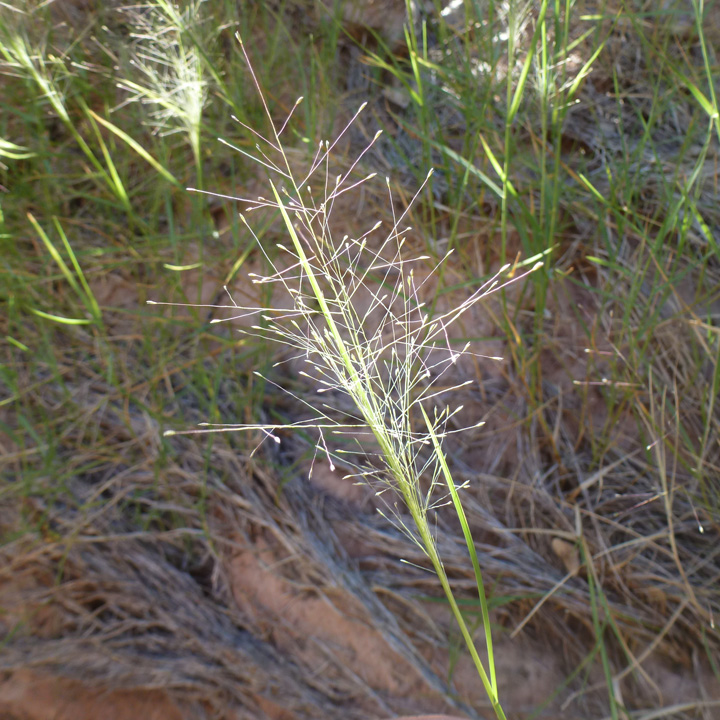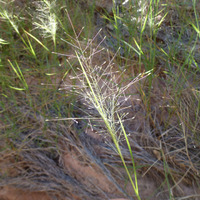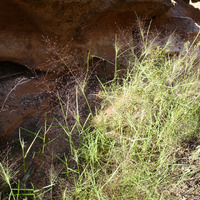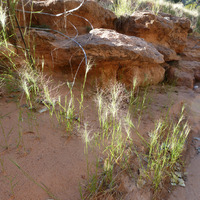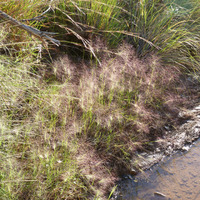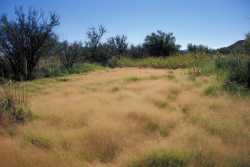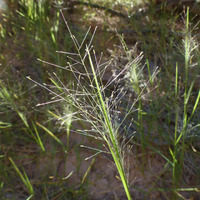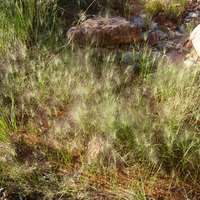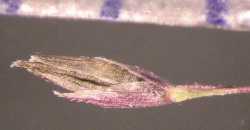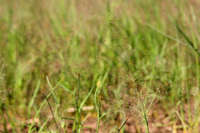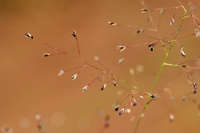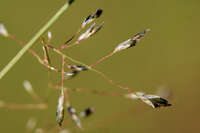Plants perennial; rhizomatous, not cespitose, occasionally stoloniferous. Culms 10-60(100) cm, decumbent-ascending, bases somewhat compressed-keeled; internodes glabrous, shiny below the nodes. Sheaths glabrous, margins hyaline; ligules 0.2-1 mm, firm, truncate, ciliate, without lateral lobes; blades 2-7(11) cm long, 1-2.8(4) mm wide, flat, occasionally conduplicate, smooth or scabridulous abaxially, scabridulous adaxially, margins and midveins not conspicuously thickened, greenish, apices acute, not sharp. Panicles 6-21 cm long, 4-16 cm wide, broadly ovoid, open; primary branches 3-12 cm, capillary, lower branches spreading 30-90° from the rachises, never appearing fascicled; pedicels 3-14 mm, longer than the spikelets. Spikelets 1.2-2.1 mm, occasionally with 2 or 3 florets. Glumes equal, 0.6-1.7 mm, purplish, scabridulous, particularly on the veins, 1-veined, apices acute; lemmas 1.2-2.1 mm, lanceolate to oblong-elliptic, somewhat plumbeous, glabrous, usually smooth, occasionally scabridulous near the apices, apices acute, unawned or mucronate, mucros to 0.3 mm; paleas 1.2-2.1 mm, lanceolate, glabrous, acute; anthers 1-1.3 mm, greenish-yellow to purplish at maturity. Caryopses 0.8-1 mm, fusiform, brownish. 2n = 20, 22, 28.
Muhlenbergia asperifolia grows in moist, often alkaline meadows, playa margins, and sandy washes, on grassy slopes, and around seeps and hot springs, at elevations of 55-3000 m. Its geographic range includes northern Mexico. Muhlenbergia asperifolia is morphologically similar to the southeastern M. torreyana, but differs in having glabrous, weakly compressed culms and more widely divergent panicle branches.
The caryopses of Muhlenbergia asperifolia are frequently infected by a smut, Tilletia asperifolia Ellis & Everhart, which produces a globose body filled with blackish-brown spores.
Perennial rhizome-bearing, sometimes runner-forming herb 10 cm - 1.2 m tall
Leaves: having open, hairless sheaths with transparent margins, and 0.2 - 1 mm long, firm, flat-topped ligules lined with hairs on the margins. The blades are greenish, 2 - 11 cm long and 1 - 4 mm wide with pointed tips, flat or sometimes folded lengthwise, smooth or minutely rough beneath, minutely rough above.
Inflorescence: terminal, spike-like and branched (panicle), open, 6 - 21 cm long, 4 - 16 cm wide, broad egg-shaped. The hair-like primary branches are 3 - 12 cm long with the lower branches spreading 30 to 90 degrees from the main axis.
Fruit: a brownish, spindle-shaped caryopsis, 0.8 - 1 mm long.
Culm: 10 cm - 1 m long, decumbent to ascending, bases compressed or folded longitudinally, internodes hairless and shiny just below the nodes.
Spikelets: 1.2 - 2.1 mm long, borne on a stalk 3 - 14 cm long.
Glumes: equal, purplish, 0.6 - 1.7 mm long, with a pointed tip and a single minutely rough vein.
Florets: one (sometimes two or three) per spikelet, with greenish yellow to purplish anthers 1 - 1.3 mm long.
Lemma: lead-colored 1.2 - 2.1 mm long, lance-shaped to oblong-elliptic, three-veined, hairless and usually smooth, sometimes minutely rough near the pointed tip, unawned or with an awn to 0.3 mm long.
Palea: 1.2 - 2.1 mm long, lance-shaped with a pointed tip, two-veined, hairless.
Similar species: Muhlenbergia asperifolia can be easily distinguished from other Muhlenbergia species in the Chicago Region. It has spreading inflorescences 4 - 16 cm across and awnless spikelets less than 2 mm long.
Flowering: mid July to early October
Habitat and ecology: Introduced from the western United States, this species is a weed of railroad ballast, waste soils, industrial areas, and along expressways.
Occurence in the Chicago region: non-native
Etymology: Muhlenbergia is named after American botanist, Gotthilf Henry Ernest Muhlenberg (1753-1815). Asperifolia means harsh-leaved.
Author: The Morton Arboretum
Common Name: scratchgrass
Duration: Perennial
Nativity: Native
Lifeform: Graminoid
General: Rhizomatous perennial grass, occasionally with stolons; stems 10-60 cm, decumbent-ascending; bases somewhat compressed keeled; internodes glabrous, shiny below the nodes.
Vegetative: Blades 2-7 cm long, 1-3 mm wide, flat, occasionally conduplicate, smooth or minutely roughened below, minutely roughened above, greenish, with acute apices; ligules less than 1 mm, firm, truncate, ciliate, without lateral lobes; sheaths glabrous.
Inflorescence: Open panicles 6-21 cm long, 4-16 cm wide, broadly ovoid; primary branches 3-12 cm, capillary; lower branches spreading 30-90 degrees from the rachises; pedicels 3-14 mm, longer than spikelets; spikelets 1-2 mm, occasionally with 2-3 florets; glumes equal, 0.5-2 mm, purplish, minutely roughened on veins, with acute apices; lemmas 1-2 mm, lanceolate to oblong-elliptic, lead-colored, glabrous, the apices acute, unawned or mucronate, mucros to 0.3 mm.
Ecology: Found in moist, often alkaline meadows, along sandy washes, on rocky to sandy slopes, and around seeps and hot springs from 4,000-6,500 ft (1219-1981 m); flowers June-September.
Distribution: Native to much of N. Amer. except for the southeast; south to c MEX and in S. Amer..
Notes: Muhlenbergia is a large and diverse genus primarily distinguished by having single-flowered spikelets with unequal glumes. M. asperifolia is distinct in being a rhizomotous perennial bunchgrass with open, sparsely-flowered, wispy panicles, and lemmas without awns. Similar to M. arenacea but much coarser, often with longer stems, broader and firmer blades (greater than 1 mm wide) without white margins and midveins, and ligules without lateral auriculate projections. The source of the common name "scratchgrass" becomes evident if you run your hand along the edge of the blades. The seeds of this species are frequently infected by a smut, Tilletia asperifolia, which produces a globose body filled with blackish-brown spores.
Ethnobotany: Unknown
Etymology: Muhlenbergia is named for Gotthilf Heinrich Ernst Muhlenberg (1753-1815) a clergyman and botanist from Pennsylvania; asperifolia means rough leaved.
Synonyms: Sporobolus asperifolius
Editor: SBuckley 2010, FSCoburn 2015, AHazelton 2015
Rhizomatous; culms tufted, glaucous, 1-5 dm, spreading or decumbent at base, rarely erect; sheaths glabrous, usually overlapping and keeled; ligule truncate, erose, 0.2-1 mm; main blades 3-7 cm נ1-2.5 mm, abruptly expanded above the collar, scabrous, especially on the cartilaginous margin; base of the panicle at first enclosed in the sheath, later exserted and the branches widely spreading, the infl open, diffuse, about as thick as long; spikelets often purple or blackish, sometimes 2-fld; glumes acute, subequal, 1-1.4 mm; lemma obtuse or subacute, 1.2-1.7 mm, awnless; 2n=20. Moist soil and streambanks, often in alkaline situations, sometimes a lawn-weed; widespread in w. U.S., e. to Minn., Io., and Mo., and intr. as far as Mich., O., s. Ont., and e. N.Y.; s. S. Amer. (Sporobolus a.)
Gleason, Henry A. & Cronquist, Arthur J. 1991. Manual of vascular plants of northeastern United States and adjacent Canada. lxxv + 910 pp.
©The New York Botanical Garden. All rights reserved. Used by permission.


